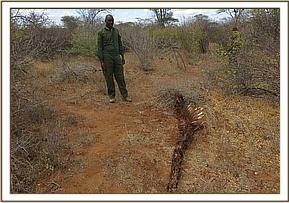Meru Conservation Area Veterinary Field Report – June 2014 Reported by - Bernard Rono Introduction: This report describes the activities of Meru Vet Unit in June 2014
Meru Conservation Area Veterinary Field Report – June 2014
Reported by - Bernard Rono
Introduction:
This report describes the activities of Meru Vet Unit in June 2014. The unit attended to 3 cases of injured elephants in Meru national park and Ol Jogi ranch which are a result of human wildlife conflict. Three hand raised black rhinos in Lewa were injured by an adult black rhino which strayed into the stockade. The baby rhinos were treated and have since recovered. Other post mortem examinations are also described in the report.
CASE#1 TREATMENT OF AN INJURED ELEPHANT
Date: 5th June 2014
Species: Elephant
Sex: Male
Age: 3years
Location: Ol Jogi Ranch, Meru
History:
On 5th June 2014 the Meru veterinary unit was alerted to an injured elephant calf in Ol Jogi ranch by a wildlife monitoring team. This was a 3 year old male elephant that had leg lameness and swelling on the right forelimb for the previous two weeks. He had difficulty keeping pace with the rest of the herd.
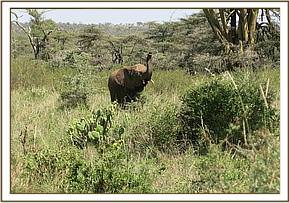

General Examination:
The elephant calf was darted on the 6th June to investigate the cause of lameness. The calf was located near a stream with its family close by and was in fair body condition. Darting was conducted on foot using Etorphine Hcl 2mg in a 1.5cc Dan Inject dart syringe. Examination showed an abscess caused by a retained arrow head penetrating into the soft tissue around the elbow joint of the calf’s right forelimb.
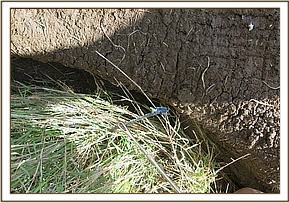

This injury may have occurred as a result of human wildlife conflict involving crop raiding elephant herds and rural farmers in Laikipia County.
For treatment:
- The arrow head was carefully retrieved using a surgical forceps with minimum trauma
- Lancing and chemical debridement of the abscess using dilute hydrogen peroxide
- Lavage with Povidone Iodine
- Betamox trihydrate LA 40ml deep intramuscularly
- 5% Flunixin Meglumine 20 ml intramuscularly


Reversal
The elephant was revived from anesthesia using Diprenophine Hcl 12mg intravenously into the superficial ear vein.


Conclusion:
Prognosis for recovery remains guarded mainly because of the risk of intractable infection of the elbow joint; recovery may also lead to joint deformity. This calf was later reported to have reunited with its mother by a patrol team who were advised to monitor its movement. A review is planned at 4 weeks post treatment though a slight improvement was reported at 2 weeks post treatment.
Acknowledgements
We would like to thank Dr. Steve, the veterinary surgeon in Ol Jogi who provided valuable support during the treatment procedure and has been monitoring the injured calf over the past 3 weeks.
CASE #2 TREATMENT OF INJURED BLACK RHINO CALVES
Date: 5th June 2014
Species: 3 Black Rhino
Sex: Male
Age: Nicky- 2years, Hope 1.5years and Kilifi 9months old
Location: Lewa Conservancy
History:
In Lewa wildlife conservancy three hand-reared black rhino male calves; Nicky, Hope and Kilifi, were viciously attacked by a male black rhino that had found its way into the stockade on 5th June.
General Examination:
An evaluation on 6th June showed superficial bruises and traumatic soft tissue injuries in the abdomen and chest.


A three day course of anti-inflammatory drug 5% Flunixin meglumine at 5mg/ kg body weight were administered and topical Oxytetracycline spray was applied. The calves have since recovered fully.


CASE #3 TREATMENT OF AN INJURED ELEPHANT
Date: 14th June 2014
Species: Elephant
Sex: Male
Age: 5years old
Location: Meru National Park
History:
On 14th June 2014 tour guides from Elsa’s Kopje reported to the unit a sub adult elephant in Meru national park which had pus discharging from a wound on the trunk. This was a 5 year old male elephant in a herd of 15 individuals.
The following day the herd was tracked to the Rojowero River and the elephant was darted at 3.25pm. For immobilization Etorphine Hcl 4mg in a 1.5cc DanInject dart was used. The dart was placed into the gluteal muscles and the elephant was down in 5 minutes.


General Examination:
A quick evaluation showed a penetrating wound at the base of the trunk and an abscess. On probing with a forceps the wound was 4 inches deep and may have been a result of foreign body penetration.


For treatment:
- Chemical debridement of the wound using dilute hydrogen peroxide
- Lavage with Povidone Iodine
- Betamox trihydrate LA 60ml deep intramuscularly

Reversal
After treatment the elephant was revived at 3.45p.m using Diprenophine Hcl 18 mg injected intravenously into superficial ear veins.
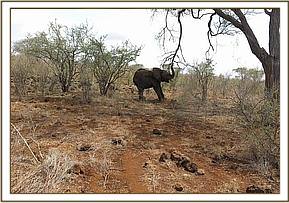
CASE #4 POST MORTEM OF AN ELEPHANT CARCASS
Date: 18th June 2014
Species: Elephant
Sex: Male
Age: 35years old
Location: Meru National Park
History:
On 18th June 2014 rangers on patrol found an elephant carcass in Mutundu river. This was an adult bull more than 35 years old which had only one tusk.
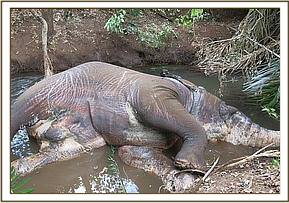
General Examination:
Inspection of the carcass showed no external injuries. The carcass which was decomposed was estimated at 3 days old. No significant findings were recorded during a post mortem examination and the cause of death was attributed to an internal disease condition.
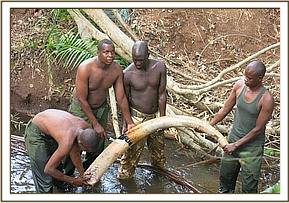
The tusk which was extracted is under custody of the company commander.
CASE #5 TREATMENT OF A SPEARED ELEPHANT
Date: 27th June 2014
Species: Elephant
Sex: Female
Age: Sub adult
Location: Meru National Park
History:
On 27th June Elsa’s Kopje tour guides reported that a sub adult female elephant in poor body condition had a tight wire snare around its trunk and had difficulty drinking water from the river. Lameness was also observed on the right forelimb. The elephant was immobilized immediately after tracking the herd from Mulika River where it was seen.
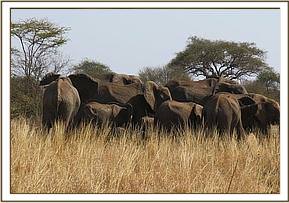

General Examination:
Standard elephant immobilization procedure was followed using Etorphine Hcl 5mg in a 1.5cc dart. It was down in 8 minutes after which the rest of the herd was driven away with a vehicle.
An evaluation showed a septic wound caused by a retained spear 40cm long into the muscles of the scapula with extensive tissue necrosis. The spear which was attached to a small polythene sheet suspected to have been poison laced causing severe tissue damage. The wire snare on the trunk caused soft tissue strangulation and a septic penetrating wound. The wounds were at least 3 weeks old.
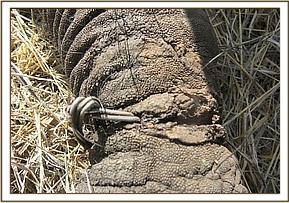

This elephant had difficulty accessing nutritious browse, in addition to septicemia from the wound infection hence poor body condition.
Treatment:
- Spear was carefully retrieved and the wire snare removed using a wire cutter
- chemical debridement of the wounds using hydrogen peroxide and iodine lavage
- parenteral antimicrobial 30% Oxytetracycline 100ml intramuscularly to treat resulting septicemia
- 1% Dexamethasone 50ml intramuscularly
- Multivitamin injection 100ml
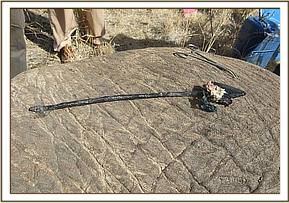
Reversal:
Without veterinary intervention this animal would have died.Prognosis for this case remains guarded due to septicemia. However, we will continue to monitor this elephant and a review will be scheduled when necessary.

OTHER CLINICAL CASES ATTENDED
Date: 3rd to 5th June 2014
Species: Giraffe
Sex: Unknown
Age: Unknown
Location: Bour Alghy Giraffe Sanctuary
The unit was alerted to an injured giraffe with a wire snare on its right forelimb in Bour Alghy giraffe sanctuary by the warden in charge of KWS station in Garissa. A three day search for the giraffe for treatment on 3rd to 5th June 2014 was not successful.
Date: 4th June 2014
Species: Hippopotamus
Sex: Male
Age: Adult
Location: Cheridede/Tana River
On 4th June the team responded to a call by local community in Cheridede on a hippopotamus which fell into a shallow well in a lugga along the banks of Tana river. The hippo, which had been stuck for the past two days, suffered severe dehydration and was in poor body condition. It was euthanized.
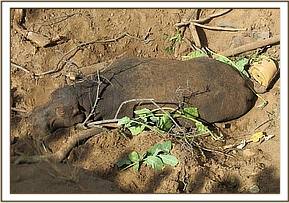
Date: 24th June 2014
Species: Reticulated Giraffes
Sex:
Age: Adult Giraffe
Location: Murera River
On 24th June the platoon commander Korbesa, reported that 2 reticulated giraffes had died along Murera river. He requested for an examination of the carcasses to determine if the cause of death was a result of a disease process. During a visit to the area the team found a skeleton of a sub adult giraffe. The carcass had been consumed by scavengers. No significant findings were recorded but we will look out in future for reports of carcasses in the area.
